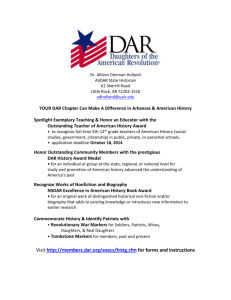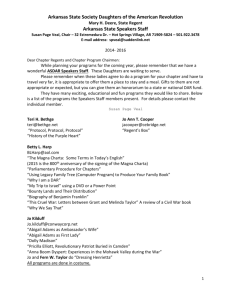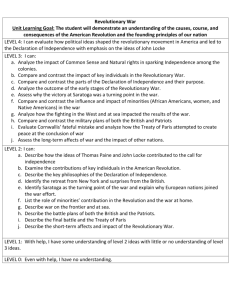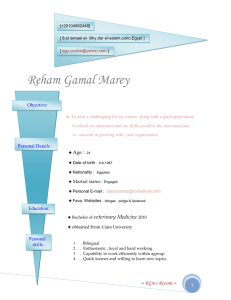12.08 Using DAR Documentation
advertisement
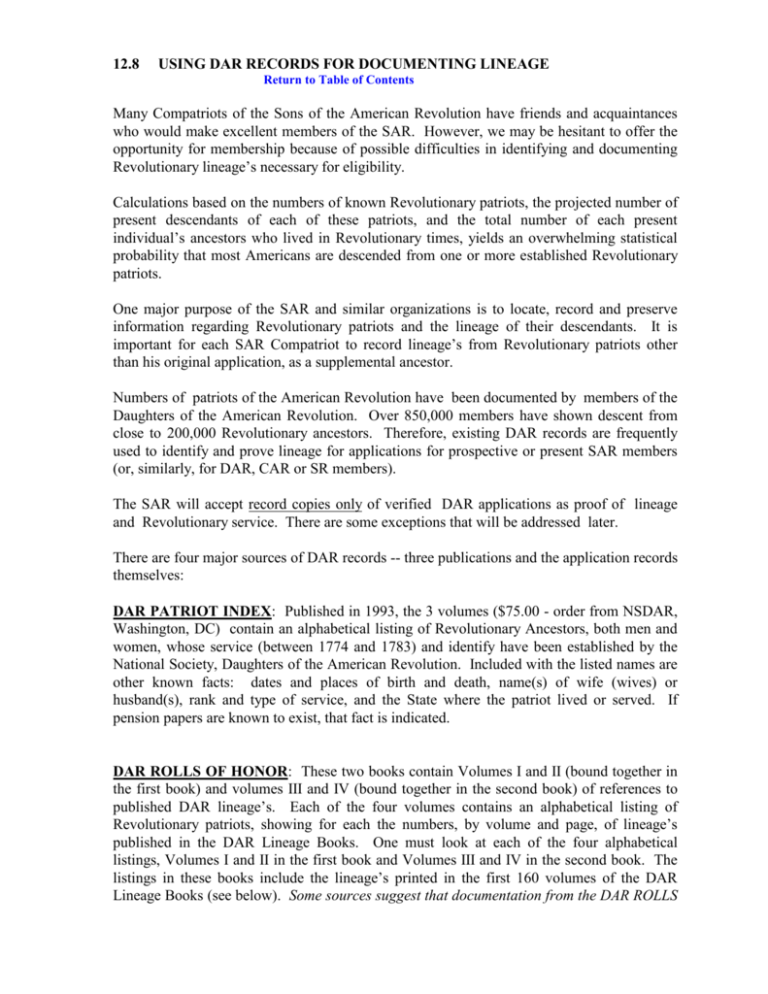
12.8 USING DAR RECORDS FOR DOCUMENTING LINEAGE Return to Table of Contents Many Compatriots of the Sons of the American Revolution have friends and acquaintances who would make excellent members of the SAR. However, we may be hesitant to offer the opportunity for membership because of possible difficulties in identifying and documenting Revolutionary lineage’s necessary for eligibility. Calculations based on the numbers of known Revolutionary patriots, the projected number of present descendants of each of these patriots, and the total number of each present individual’s ancestors who lived in Revolutionary times, yields an overwhelming statistical probability that most Americans are descended from one or more established Revolutionary patriots. One major purpose of the SAR and similar organizations is to locate, record and preserve information regarding Revolutionary patriots and the lineage of their descendants. It is important for each SAR Compatriot to record lineage’s from Revolutionary patriots other than his original application, as a supplemental ancestor. Numbers of patriots of the American Revolution have been documented by members of the Daughters of the American Revolution. Over 850,000 members have shown descent from close to 200,000 Revolutionary ancestors. Therefore, existing DAR records are frequently used to identify and prove lineage for applications for prospective or present SAR members (or, similarly, for DAR, CAR or SR members). The SAR will accept record copies only of verified DAR applications as proof of lineage and Revolutionary service. There are some exceptions that will be addressed later. There are four major sources of DAR records -- three publications and the application records themselves: DAR PATRIOT INDEX: Published in 1993, the 3 volumes ($75.00 - order from NSDAR, Washington, DC) contain an alphabetical listing of Revolutionary Ancestors, both men and women, whose service (between 1774 and 1783) and identify have been established by the National Society, Daughters of the American Revolution. Included with the listed names are other known facts: dates and places of birth and death, name(s) of wife (wives) or husband(s), rank and type of service, and the State where the patriot lived or served. If pension papers are known to exist, that fact is indicated. DAR ROLLS OF HONOR: These two books contain Volumes I and II (bound together in the first book) and volumes III and IV (bound together in the second book) of references to published DAR lineage’s. Each of the four volumes contains an alphabetical listing of Revolutionary patriots, showing for each the numbers, by volume and page, of lineage’s published in the DAR Lineage Books. One must look at each of the four alphabetical listings, Volumes I and II in the first book and Volumes III and IV in the second book. The listings in these books include the lineage’s printed in the first 160 volumes of the DAR Lineage Books (see below). Some sources suggest that documentation from the DAR ROLLS OF HONOR is no longer accepted by DAR National. The reason seems to be because the information in these volumes has not been scrubbed or validated for accuracy, since they were published so long ago. In that regard we suggest that you use it for a primary reference source or for clues. DAR LINEAGE BOOKS: This set of 166 volumes contains individually printed lineage’s of DAR members, in the order of their admission and therefore of their DAR National Numbers. The lineage in the first 160 volumes are shown in the DAR Roll of Honor, referenced above. The remaining six volumes (volume 161 through 166) contain their own indices. RECORD COPIES: of individual original DAR applications, available from the National Society, DAR. (see Step 6 below for details - in some instances the Record Copy is the first step). Be sure to obtain an authorized Record Copy which can only come from the NSDAR, Washington, DC. STEPS IN LOCATING AND OBTAINING RECORDS Locate sources in the above three DAR publications. The Patriot Index and the Roll of Honor are available in many libraries. The reference desk of your local public library can either direct you to these volumes, or locate for you the nearest library containing them. Step 1: Ask the applicant if he has a relative who is or was a member of the DAR, SAR or SR. He should be urged to inquire of his family for current or past DAR members Mothers, grandmothers, aunts or cousins who share his ancestry. If such a relative is found, go directly to Step 5 and obtain a “record copy” of the application. If such a DAR relative is found, go directly to Step 5 to obtain a “record copy” of her application. If not, proceed to Step 2. DAR members may be reluctant to hand out membership rosters. However, they will usually be delighted to provide such information when the purpose is explained. DAR members are helpful in recommending applicants to us, assisting them with preparation of applications and documentation. Step 2: Furnish the candidate an SAR worksheet and urge him to get as much information as he can provide on his ancestry. Frequently one or more family members have a particular interest in family history, and simply asking may yield considerable information. All personal and published sources should be utilized. List all known family surnames. Male and female should be listed to consider all possible paternal and maternal lines, multiplying the opportunities for locating one or more suitable lineage’s. Add the given names of male ancestors in each surname living in the late 1700’s. If the knowledge of a family name does not extend back that early, add the given name of the earliest know ancestor of that name. Then proceed to Step 3. Step 3: Consult the DAR Patriot Index. Where two or more patriots have the same or similar first and last names, the spouse and state information given may identify your potential ancestor in question. Under the surname you may find a patriot likely to be your line. Clues may include the surname of the spouse, the given names of the patriot or spouse, and the state of service. For example, if you had an ancestor living in the 1800’s named Marshall Giles, and you find a Patriot named William Giles who married Rebecca Marshall, you should order a RECORD COPY on that patriot from NSDAR. If a potential ancestor is found in the Patriot Index, proceed to Step 4. If not, proceed to Step 8. Step 4: Consult the DAR Rolls of Honor. Be sure to look at all four alphabetical listings -two in each book, Volume I and II in the first book and Volumes III and IV in the second book. Record the numbers (referring to volume and page in the DAR Lineage Books under each listing found for the ancestor(s) in question, and proceed to Step 5. If there are listings of two or more patriots of the same given and last names, you may or may not be able to tell which is the one. You may need to “sample” the lineage of each. Should you find an ancestor, but cannot locate him in the Rolls of Honor, this implies that the original application sent to DAR was approved after Volume 160 of the DAR Lineage Books was published. In this case, proceed to Step 6, writing for a “record copy” of a DAR application on the ancestor in question. Step 5: Consult the DAR Lineage Books for the published lineage’s of DAR descendants of the ancestor(s) in question, looking at each volume and page copied from the listings in the Rolls of Honor (Step 4). This is done most easily by looking at the books themselves. You may obtain photocopies of the lineage record by mail, giving the volume, page, and the ancestor’s name. In the Macon area there is a library containing these volumes. (hours 9 a.m. to 6 p.m., closed Sundays: telephone 912-744-0820). This library has been very responsive to such requests, sending copies promptly at nominal copying costs. A sample letter requesting such copies follows: Genealogical and Historical Room Washington Memorial Library P. O. Box 6334 Macon, GA 31208 Dear Madam or Sir: Please send me photocopies of the following lineage’s from the Lineage Books published by the Daughters of the American Revolution: Ancestor John Smith Hans Ulrich Schmidt William Giles Volume 12 45 159172 13576 37 Page 123 17 206 38 118 I have enclosed $2.00 for the cost of these copies (I figure $.20 per copy, plus postage, and round off to the next highest dollar, enclosing cash). Thank you in advance for offering and providing this very useful service. Sincerely, The purpose of obtaining the above printed DAR lineage is to identify, by specific DAR member and National Number, the application referring to the ancestor in question, and to determine which application may give the most information and documentation. The first application on a particular ancestor will show the sources of documentation for the Revolutionary service as well as the applicants lineage. Whereas subsequent applications may simply refer to a previous application(s) as source of documentation. However, a subsequent application may reveal generations more in common with the proposed SAR applicant. A Record Copy of both applications may yield genealogical information important to personal family history. If material published in the Lineage Books appears to be of value proceed to Step 6. In some cases, Step 5 may be bypassed and you may proceed directly to Step 6, ordering record copies. The only distinct advantage of Step 5, using the Lineage Books, is to maximize the potential for obtaining documentation of as many generations as possible shared with the SAR applicant. This may not be necessary in some cases, where documentation of these generations is provided by other sources. Another advantage, that of allowing a request for a specific application by the applicant’s name and number, is not necessary when documentation only of the ancestor’s service and child or children is required. In this case, a “record copy” may be requested by the name of the ancestor, rather than by a specific DAR member. Step 6: Obtain a “record copy” of the DAR application. To request, give the full name of the applicant and her DAR National Number. If her number is not know, then give her town or city of residence (at the time of the DAR membership), so that her application can be identified. If you run into difficulty obtaining the information from the DAR, contact your GASSAR Secretary. You may find a Revolutionary ancestor listed in the DAR Patriot Index, but not find him in the Rolls of Honor because the first application submitted by descendant was after publication of latter books as explained earlier. In this case, you may wish to request a “record copy” of the first application utilizing that ancestor, rather than a record copy of a specific applicant. Be sure to enclosed a check for the current cost of each record copy which is currently $5.00. A sample letter requesting a record copy may be found in Section 12.9 DAR Form Letter to Obtain Record Copies, of this document. Step 7: Use the DAR “record copy” as documentation of the Patriot’s service and any generations of descent shared with the SAR applicant. Copy this information from the record copy into the appropriate spaces in the lineage section of your SAR application. In the sections “for references”, write in the space opposite the generation number (shared and documented on the DAR record copy), and in the space for references as to the ancestor’s Revolutionary War Serevice..”See enclosed record copy of DAR application, Nat. #_____” If the DAR record copy documents more than one generation in common with the SAR applicant, simply write “See ____Generation” in the spaces for the subsequent generations thus documented. ___ being the number in which the full citation of the record copy is given. A photocopy of the DAR record copy you have ordered should be submitted with the SAR application. In some cases, the SAR applicant may have more complete or correct information regarding the Revolutionary ancestor and subsequent generations than is shown on the DAR record copy. In this case, it is suggested that the additional or corrected information and its documentation be submitted along with the “record copy” of the DAR application, so that permanent files of the SAR will contain the most nearly complete and correct information available. Early DAR applications do not show the “place & state” of birth, death and marriage in each generation, whereas current SAR applications request this information. Proof of locations is not required. The location of each event shown on the SAR application should be recorded, even if only by state, but may be left blank if the location is unknown. The SAR generally accepts lineage’s and documentation of service previously accepted for DAR membership. In some cases, documentation of prior DAR applications may be considered insufficient, so that additional documentation may be requested of SAR applicants. Next, the descent from the latest direct ancestor shown on the DAR “record copy” to the SAR applicant must be recorded and documented. If the DAR member is his maternal aunt, this can be as simple as providing the applicant’s birth certificate and his mother’s birth or death certificate, showing that he is the grandson of his aunt’s parents. Or, it may require documentation of several generations It is beyond the scope of this presentation to detail methods of documentation, but will mention simply that obtaining birth and/or death certificates for each person in the direct line of descent who has been born or has died since such records became required, can readily document up to several generations, as each such document should contain the names of the parents of the person whose birth or death was recorded. This step normally completes the documentation required for original or supplemental applications. Step 8: This step is included for those cases in which a known or suspected Revolutionary patriot ancestor is not found to have been previously documented by one or more DAR applicants. In such cases, documentation must be provided for both the Revolutionary service of the ancestor and for the descent to the applicant. The above outlined methods have assisted many in identifying numerous Revolutionary ancestors and documenting patriot service and partial lineage. Hopefully these methods may do the same for you. AMD ‘96 SUGGESTED SOURCES FOR DOCUMENTING RECENT GENERATIONS BIRTH Complete Birth Certificate(long form) Hospital Certificate/Record Doctor/Midwife Record Church Record HMO Record Census-State, Federal Birth Record Newspaper Announcement School Record Baptismal Certificate Social Security Application Job Application/Federal-local MARRIAGE Complete Marriage Record Marriage Bond/Bann Divorce Church Marriage Certificate Newspaper Announcement Tombstone/Cemetery Record DEATH Death Certificate(long form) Cemetery/Tombstone Record Commercial Cemetery Record Funeral Home Records Insurance Policy Church Record/Notice Obituary Mourning/Funeral Card Professional Organizations Fraternal Organization Records CLASSIC SOURCES Census-State, Federal Land Records Military & Pension Records Tax Records Probate Records Bible & Family Records Church Registers & Records Encounters with the Law PROBLEM AREAS Sworn statements & Affidavits Unreadable records Certificate of Failure to locate records Records in a foreign language Tradition SUGGESTED BIBLIOGRAPHY OF RESOURCES FOR SERVICE CT. Johnson, Henry P., ed. Connecticut Adjutant General’s Office. The Record of Connecticut Men in the Military and Naval Service during the War of the Revolution, 1775-1783. Hartford: 1889. DE Public Archives Commission. Delaware Archives. Vols. 1-3. Wilmington: Mercantile Publishing Co., 1911-1919. GA Davis, Robert S. Jr. Georgia Citizens & Soldiers of the American Revolution. Easley, SC: Southern Historical Press, 1979. Hitz, Alex M., comp. Authentic List of All Land Lottery Grants Made To Veterans Of the Revolutionary War By The State Of Georgia. Secretary of State of Georgia. Atlanta: 1955. O’Kelley, Nicole M. and Warren, Mary Bondurant, trans. Georgia Revolutionary Bounty Land Records, 1783-1785. IL Records of Military Service will be found in Virginia records. KY Records of Military Service will be found in Virginia records. Drake, Mrs. Wm. Preston, et al. Kentucky in Retrospect 1792-1967. Frankfort: Kentucky Historical Society, 1967 ed. Harding, Margaret H. George Rogers Clark and his Men: Military Records 1778-1784 Frankfort: Kentucky Historical Society. ME Maine was part of Massachusetts during the Revolutionary War. Records for military service may also be found in Mass. Fisher, Carleton E. & Fisher, Sue G. Soldiers, Sailors and Patriots of the Revolutionary War Maine. Louisville, KY: NSSAR, 1982. MD War Clements, S. Eugene & Wright, F. Edward. Maryland Militia in the Revolutionary Family Line Publications, 1991. Archives of Maryland, Muster Rolls and other Records of Service of Maryland Troops MA NH 1775-1783. Vol 18. Tolzmann - Maryland German Heritage - Settlers & Immigrants. Massachusetts. Secretary of the Commonwealth. Massachusetts Soldiers and Sailors of the Revolutionary War. 17 Volumes. Boston, MA: Wright & Potter, 1896-1908. Microfilm 8 rolls. Batchellor, Albert Stillman, Miscellaneous Revolutionary Documents of New Hampshire Vol. 30. State Papers Series. Manchester, NH: John B. Clarke Co., printer, 1910. Bouton, Nathaniel. Documents and Records Relating to the State of New Hampshire 1776-1783. Vol. 8. State Papers Series. Concord, NH: Edward A. Jenks, Printer. 1882-1884. Hammond, Isaac W. Town Papers: Documents Relating to Towns in NH Vols. ll-l3 State Papers Series. (Revolutionary Rolls 1-4). NJ Stryker, Wm. S., compiler. Official Register of the Officers and Men of New Jersey in the Revolutionary War. Trenton: 1872. Baltimore: Genealogical Pub. Co. 1965 NY Ferenow, B. New York in the Revolution. Vol. 15. New York State Archives Albany, NY: 1887. Mather, F.C. The Refugees of 1776 from Long Island to Connecticut . Albany, NY: J. B. Lyon Co. 1913. Roberts, J. A. New York in the Revolution Colony and State. 2 vols. Albany, N. Y. J. B. Lyon Co. 1901-1904 (NY Comptroller’s Office). 1 vol. 1898 NC Clark, Walter, ed. The State Records of North Carolina. 30 vols. Nash. Goldsboro, NC: 1866-1907. Ibid. Vol. 16 Ibid. Vol. 4 Rosters Ibid. Vol. 10 Vols. 27-30 Rosters Ibid. Vol. 22. p. 75 Oaths of Allegiance Haun, Weynette Parks. North Carolina Revolutionary Army Accounts. Durham: Weynette Parks Haun, Part I (1989). Part II (1990). Part III (1991). Part IV (1992). See individual book for explanation plus Leary & Stirewalt’s NC Research, p. 362-364 for a discussion of these records. PA Pennsylvania Archives. RI Smith, Joseph J. Civil and Military Lists of Rhode Island 1647-1800. Providence 1900 Walker, Anthony, So Few the Brave: Rhode Island Continentals. 1775-1783 Newport: RI Society SAR, 1981. SC Moss, Bobby Gilmer. Roster of South Carolina Patriots. Baltimore, MD: Genealogical Publishing Co., 1983 Salley, A.S., Jr. and Wates, W.A. Stub Entries of Indents Issued in Payment of Claims Against South Carolina Growing Out of the Revolution. 12 vols. Columbia, SC SC Dept. of Archives and History, 1810-57. TN Cartwright, B.G.C. & Gardiner, L.J. North Carolina Land Grants in Tennessee 1778-91. Memphis: Harper, 1958. Ibid. Section 3 ONLY. List of military grants to soldiers of the North Carolina Line in Middle Tennessee. VT Goodrich, John R., ed Rolls of the Soldiers in the Revolutionary War 1775 to 1783. Rutland, VT: The Tuttle Co., 1904. VA Eckenrode, H. J. List of Revolutionary Soldiers of Virginia. Virginia State Library Bottom. Richmond, VA: 1911. Ibid. Supplement. 1911, 1912 Special Reports. Gwathmey, J. H. Historical Register of Virginians in the Revolution . Richmond, VA: 1938. Dietz. Revolutionary War Pension Dates of Interest 26 Aug 1776 Invalid pensions for officers and soldiers, half-pay during disability, continental line. 24 May 1780 Widows and orphans of officers of Continental Army, half-pay for seven years, rescinded 28 July 1789. 21 Oct 1780 Service pension for life for officers of Continental Army only, rescinded 04 Aug 1790. 28 Jul 1789 Federal government assumes state invalid pensions, 03 Mar 1804 Federal government assumes all of South Carolina invalid pensions, continental line. 03 Mar 1805 Invalid pensions to those disabled since the war for wounds incurred during the war, continental line. 10 Apr 1806 Invalid pensions extended to volunteers, militia and state troops. 1813 Military records burned in War of 1812 including pension applications prior to 1813. 18 Mar 1818 Service pension for “cont. Established T?” Act of 1820 removed many. 15 May 1828 Service pension for officers and soldiers eligible for pension under resolution of 21 Oct 1780, full pay for life. 07 Jun 1832 First service pension for all Revolutionary soldiers and sailors, continental and state. Widows and orphans entitled to balance of money due a pensioner. 04 July 1836 Widow’s pension for widow of Revolutionary soldier, on pension rolls of 1828, married during last term of service or before 3 Nov 1783. 07 July 1836 Pension for widow if married before 1 Jan 1794. 03 Mar 1837 Revolutionary widow entitled to pension even if remarried. 03 Feb 1853 Revolutionary widow entitled to pension, regardless of date of marriage. 05 Apr 1869 Daniel F. Bakeman, last Revolutionary pensioner, dies. 11 Nov 1906 Esther S. Damon, last pensioned Revolutionary widow, dies. continental line. AMD ‘96


